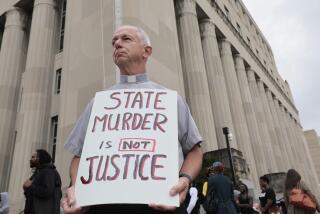Torture memos resemble Clarence Thomas’ way of thinking
Reporting from Washington — According to Supreme Court Justice Clarence Thomas, a prisoner who was slammed to a concrete floor and punched and kicked by a guard after asking for a grievance form -- but suffered neither serious nor permanent harm -- has no claim that his constitutional rights were violated.
Thomas objected when the high court, in a little-noted recent opinion, said this unprovoked and malicious assault by a North Carolina prison guard amounted to cruel and unusual punishment.
The court’s decision came a few days after Thomas’ now-famous former law clerk John C. Yoo was charged with flawed reasoning, but not professional misconduct, as a Justice Department lawyer when he applied much the same view toward the treatment of Al Qaeda prisoners.
In the so-called torture memos in 2002, Yoo reasoned that subjecting prisoners to simulated drowning or “stress positions” in cold cells was not illegal torture because it did not cause the intense pain of a serious injury, equivalent to “death or organ failure.”
Thomas’ consistent record of dismissing claims of prison brutality, most of them joined by Justice Antonin Scalia, shows that Yoo’s view of torture was not that of a rogue lawyer. Instead, it represents a strain of conservative thinking that looks back in history to define cruelty and torture, rather than toward what the court has called the “evolving standards of decency.”
Over two decades, Thomas and Scalia have repeatedly dissented when the court ruled for prisoners who alleged they were subjected to cruelty. They include an inmate who was handcuffed to a “hitching post” and forced to stand shirtless for seven hours in the hot summer sun of Alabama. Another involved an inmate from Louisiana who was repeatedly punched in the mouth by a guard.
According to Thomas, this harsh treatment did not qualify as cruel and unusual punishment. “Judges -- not jailers -- impose punishment,” he wrote.
The two justices explained that the word “punishment” as it was used in the English Bill of Rights in 1689 referred to judges imposing punishment for a crime. Prison guards do not impose “punishment” even if they mete out cruelty, they said.
Scalia raised eyebrows when he repeated this view on the CBS TV program “60 Minutes.” When asked about torture and cruelty toward prisoners, he discounted the possibility. “Has anyone ever referred to torture as punishment? I don’t think so,” Scalia said. “What’s he punishing you for? He’s trying to extract” information, he said.
Yoo took a similar approach in his 2002 memo. He said a CIA interrogator could not violate the law against using torture if his “specific intent” was to obtain information rather than to inflict pain.
This is one area of law where Thomas and Scalia are not in sync with the court’s other conservatives.
When he was a young Justice Department lawyer, Chief Justice John G. Roberts Jr. argued on behalf of Keith Hudson, the Louisiana inmate who had been punched in the mouth and kicked by a prison guard. A supervisor stood by and told the officers “not to have too much fun.” The punches left Hudson with a swollen face, loosened teeth and a cracked dental plate. Roberts argued in 1991 that this unprovoked beating was cruel and unusual punishment, and the high court agreed in a 7-2 decision in Hudson vs. McMillian.
Thomas and Scalia dissented and said Hudson did not have a “serious injury.” Justice Harry A. Blackmun took them to task for this view. If adopted, it would “place various kinds of state-sponsored torture and abuse entirely beyond the pale of the Constitution,” Blackmun wrote. As examples, he cited “whipping them with rubber hoses, beating them with naked fists, shocking them with electric currents, asphyxiating them short of death, intentionally exposing them to heat and cold, or forcibly injecting them with psychosis-inducing drugs.”
The same issue of prison cruelty arose two weeks ago in the case from North Carolina. In a 7-2 decision, with Roberts in the majority, the court revived a suit from Jamey Wilkins, who had filed a handwritten petition to the justices. He had been punched and kicked, but a judge threw out his claim without a hearing because he did not show he had suffered a serious or permanent injury.
The Supreme Court reversed this decision and repeated its view that the use of “excessive physical force” is cruel and unusual punishment if it is malicious and unprovoked.
“I continue to believe Hudson was wrongly decided,” Thomas said.
More to Read
Sign up for Essential California
The most important California stories and recommendations in your inbox every morning.
You may occasionally receive promotional content from the Los Angeles Times.











